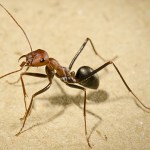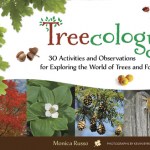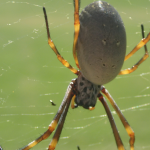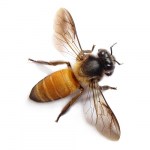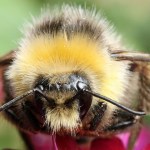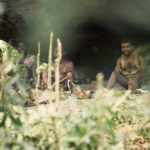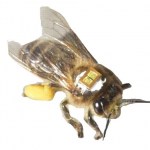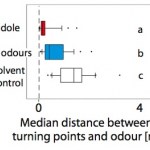insects
There is some interesting new research out on the Asian Fruit Fly, Drosophila suzukii.
The short version: This sort of fruit fly ruins fruit crops because it prefers to, and is able to, lay its eggs on harder, firmer, unrotten, and, essentially, ripe fruit, thus ruining it. Regular fruit flies focus on rotten fruit such as groundfall.
The Asian fruit fly manages this because of slightly different fruit detection mechanisms, though some of the details of this are not yet known. In the future, it is hoped that the exact chemical used by this fly to find its target ripe fruit can be…
I've got this press release that will be of interest to many:
An international team including researchers at the university of Edinburgh and Antoine Wystrach of the Research Centre on Animal Cognition (CNRS/Université Toulouse III—Paul Sabatier) has shown that ants can get their bearings whatever the orientation of their body. Their brains may be smaller than the head of a pin, but ants are excellent navigators that use celestial and terrestrial cues to memorize their paths. To do so, they use several regions of the brain simultaneously, proving once again that the brain of insects is more…
A new study illuminates this shadowy question. First, the video:
And now, a press note from the American Chemical Society:
Water striders' ability to walk and jump on the surfaces of ponds and lakes has long amazed curious observers — and inspired robot designers who want to mimic the bugs' talent. Now, scientists have measured for the first time key parameters that allow them to walk on water — by studying their leg shadows. The findings, reported in the ACS journal Langmuir, could contribute to designs for water-skimming robots.
More than 2,000 years ago, Greek scientist Archimedes…
Treecology: 30 Activities and Observations for Exploring the World of Trees and Forests is an excellent new nature activity book for kids of a fairly wide range of ages.
Like a tree, the pattern of the book is pretty straightforward but fractal like; you start off simple but end up pretty much anywhere in the world of ecology. The book begins with the basic definition of a tree, simple tree anatomy, some phylogeny, some tree physiology and biology, but then branches off (pun intended) into things that are related to trees, like things that live on them, eat parts of them, etc. Seeds and…
A new study from researchers at the University of Sydney shows that golden orb-weaving spiders (Nephila plumipes) that live in the city are larger and produce more offspring as compared to country living.
When they say the spiders are big, they mean really big. The females can reach up to 20-25mm (males are only ~5mm).
Image from Spiders of Australia http://ednieuw.home.xs4all.nl/australian/nephila/Nephila.html
The researchers speculate that the urban heat island effect, which is attributed to a lack vegetation and hard surfaces, may lead to the increased body size as invertebrates in…
Bioscience for the future has an update o the bee situation in Europe.
Europe has 13.4 million too few honeybee colonies to properly pollinate its crops, according to new research from the University of Reading.
The discovery, made by scientists at the University's Centre for Agri-Environmental Research (CAER), shows that demand for insect pollination is growing five times as fast as the number of honeybee colonies across Europe as farmers grow more insect-pollinated oil crops, such as oilseed rape and sunflowers, and fruit.
Click here to read all about it.
Here's a video:
Published on Jan 8…
This is a cool two part Youtube video that explains a lot of interesting science.
Part I:
Part II:
We recently discussed news from the EU on banning neonicotinoid pesticides in order to stem the so called Colony Collapse Disorder (CCD) among honey bees. Bug Girl has an important guest post on the phenomenon of CCD by bee expert Doug Yanega. This is a must read not only for those interested in bees and CCD, but skepticism and science reporting in general, as Yanega places the current discussion in a strong historical context and provides a valuable critique of much of the reporting on CCD. Go read Honey bees, CCD, and the Elephant in the Room.
______________
Photo Credit: wildxplorer via…
Being a bee is hard. I'm speaking specifically of the honey bee, Apis mellifera, the one that produces the honey you buy in the store. Many insects, and other critters, eat by finding food and then eating it, and then they do that for a while and now and then reproduce by finding a mate, laying eggs that they perhaps put in a good location but thereafter leave alone, etc. etc. But honey bees do all of these thing in a way that makes it seem like they are trying to make it harder for them than it is for everyone else. Much of the food that honey bees eat is gathered at rare and hard to…
I have been remiss in not posting articles from the homepage here on Page 3.14...so to catch up, here's four at once.
No Beauty Without Water
On World Water Day, think of the water cycle that defines this planet. On The Pump Handle, Liz Borkowski writes "rivers often flow through multiple countries, and actions by one country or community can affect their neighbors’ ability to meet their water needs. Consuming too much water, or polluting a shared body of water, can make it hard for others to have enough for drinking, hygiene, agriculture, ecosystem health, and other needs." Rivers and…
I read an interesting article today on how eating insects may save the world. The rationale: eating insects are not only nutritious (high in protein and fat), but would also help to save the Earth's resources as the human population continues to expand.
According to Aaron T. Dossey, a biochemist, entomologist, and founder and owner of All Things Bugs, humans consume ~40% of potential terrestrial productivity and livestock currently takes up ~30% of the Earth's land (pasture and growing feed). With the growing population of humans, food consumption will necessarily increase. He sees insects…
I knew a couple who had spent a lot of time in the Congo in the 1950s. He was doing primatology, and she was the wife of the primatologist. And when she spoke of the Congo or Uganda, where they spent most of the time, she always said "The thing about Africa is that there's no place to sit down."
Now, I've been all over Africa, and I've sat down in Nigeria, Kenya, Lesotho, Botswana. I admit having had a hard time finding a place to sit down in Namibia but that's because I've only been in places with no chairs but there were a lot of rocks. I once sat for a long time on a curb in Rwanda.…
I want to tell you about a cool book, but first, here's something interesting about Dragonflies. Terrestrial animals (like humans) require long chain fatty acids but don't synthesize them from basic parts. Higher terrestrial plants don't make the biggest of these molecules either, but plants do make molecules that can be turned into things like EPA and DHA in animals. So, while terrestrial animals can get what they need by consuming other animals or by starting out with plant molecules, it is a long slog from a bunch of readily available simple molecules to large and hard to get but very…
A commonly used insecticide, and possibly an increasingly widely used form of that pesticide, could be a causal factor in bee colony collapse. It is not 100% certain that this pesticide's effects can be counted as one of the causes this problem, but there is a very good chance that neonicotinoids can cause a drop in hive population, and thus, should be examined to see if there is a relationship in some cases. From the paper's abstract:
Nonlethal exposure of honey bees to thiamethoxam (neonicotinoid systemic pesticide) causes high mortality due to homing failure at levels that could put a…
Thanks for visiting!The contents of this post have been updated and moved to THIS LOCATION. Please click through. Sorry for the inconvenience!
Speaking of people eating insects ... as we were ... I do have this fun story from the Ituri Forest.
One day something funny happened. I was traveling in the most remote part of Central Africa, several days walk from any place you could possibly drive a car, visiting uncharted villages mainly occupied by people who had moved into the deep forest because they were in trouble with the "law" in some way (usually for perfectly good reasons in this lawless country). I was traveling with a Lese Villager and his sister, who was hired as our cook, and three Efe Pygmy men. We visited a village that…
I have written before of insects in the Ituri Forest. (Oh, and here too.) When it comes up that I've spent time there, certain questions often come up, and one of them is: "Did you eat bugs."
Every one has seen those National Geographic specials where some natives somewhere are eating insects, and of course, Westerners who think they generally don't eat insects are fascinated with the idea. Of course, Westerners eat a lot more insects than they think. You should really consider any processed food you eat that started out as a plant crop to be part insect. If what you are eating is made…
A version of this post was originally published on my Wordpress blog on March 15, 2010. Click the archives image to see the original post.
Most animals, at some point in their day-to-day lives, face the same problem. After they've gone out in search of food, they need to find their way home. But some of the places where these critters live lack any real visual landmarks - like the open ocean or wide expanses of desert. Instead of relying on vision, some animals have developed the ability to use olfactory (scent-related) cues to aid in navigation. Seabirds can detect subtle changes in the…
Human infants have one important job during the first years of life, and that is to learn about the world and their culture from their parents and other caregivers. But what is learning? I've previously written that Hungarian developmental psychologists Gergely and Csibra have defined learning as the acquisition of new, generalizable knowledge that can later be used within a new context. Further, they have posited that evolution has prepared humans to learn generalizable knowledge from their caregivers. They proposed an elegant hypothesis: that a specialized innate pedagogy mechanism - called…
Given the recent elephant hunting scandal, I thought I'd repost this award-winning piece from the archives, on a very clever way to deter elephants from raiding human settlements. Much cleverer than shooting them. (Click on the archives icon for the original.)
What information is contained in the call of a mammal? Some calls might reflect the internal emotional state of the animal, like fear or anxiety, or they can refer to an external object, agent, or event, like the presence of a predator. Rhesus monkeys, lemurs, baboons, and guinea pigs, for example, will produce calls when separated from…

